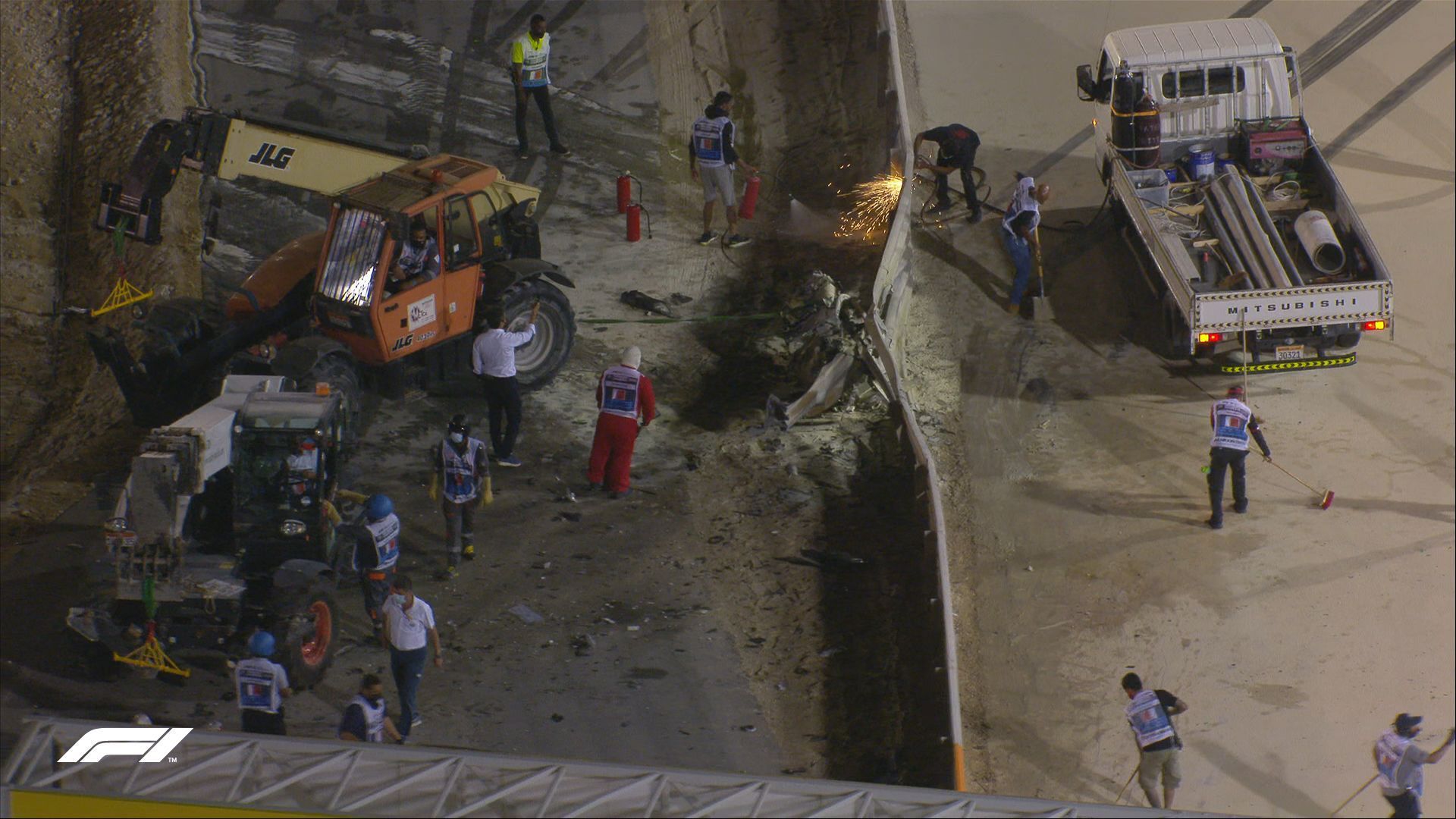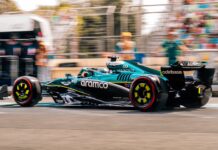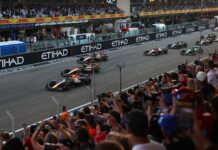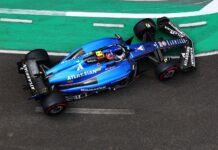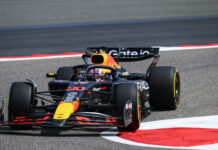The FIA releases details for F1 Sakhir GP weekend along with how they are investigating Romain Grosjean’s incident as Fernando Alonso ready for special run.
After an emotive Bahrain GP at the traditional Bahrain International Circuit, F1 revisits this venue, albeit on a new layout for this weekend, with the outer circuit, comprised of eleven corners, that some have controversially called an “almost oval.” Prior to the race here, the FIA has released preview details on the track, and those who will steward the Grand Prix.
The track will feature two DRS zones – one less than the traditional circuit – with the first detection point coming 50 meters before turn one, and the first activation point 23 meters after turn 3. A second DRS zone will be 170 meters after turn 11, with this detection point 100 meters before T10.
Drivers will circulate the short, 3.543 km circult 87 times on Sunday, with its three sectors, the first of which ends between turns three and four, and the second of which ends on the exit of turn nine. Lap times are expected to be among the shortest seen in F1 history, below 60 seconds if projections are to be believed.
The race will not have the highest ever lap count, but it will have one greater than that seen in the Pacific GP in 1995, which is the last race on the calendar to have had a similar number of laps at 83. The stewards for the F1 Sakhir GP include Garry Connelly, Loic Bacquelaine, Mika Salo, and Mazel Al-Hilli, who is the national steward of the race.
Al-Hilli also serves as the president of the Bahrain Circuit Racing Club. These stewards are the same as those who served in the last race, overseeing the tumultuous Bahrain GP. After a u-turn during last weekend’s grand prix with regards to Turn 4 track limits, this weekend’s F1 Sakhir GP will have no corners being monitored for track limits.
As a result of Romain Grosjean’s crash, the FIA’s race note confirms changes at Turn 3. The guardrail is back, replacing the temporary concrete and in addition to that a tyre barrier has been installed in front of the guardrail on the right-hand side at Turn 3.
Additionally, the tyre barrier on the right hand side of Turn 9 will be extended and increased, whereas the kerb between Turn 8 and Turn 9 will be removed. Here’s the document from the FIA: https://www.fia.com/sites/default/files/decision-document/2020%20Sakhir%20Grand%20Prix%20-%20Race%20Directors’%20Event%20Notes%20.pdf
La FIA ha vuelto a poner guardariles en lugar de los muros de hormigón provisionales en la zona de accidente de Grosjean
FIA has put barriers again to replace the provisional concrete wall in Grosjean's accident area. pic.twitter.com/ReDruvX5TG
— Albert Fabrega (@AlbertFabrega) December 2, 2020
FIA ha añadido 2 filas neumáticos y cinturón en zona accidente Grosjean. Entiendo que aún no han terminado.Guadarail siguiente sigue sin
FIA added 2 rows of tyres with conveyor belt on Grosjean accident barrier. I understand job not finishied yet, as following one isn't done yet pic.twitter.com/CopggSBtiT
— Albert Fabrega (@AlbertFabrega) December 3, 2020
https://twitter.com/AlbertFabrega/status/1334465360943255558?s=20
Staying with the FIA, it released details on how they will investigate the Grosjean incident, the outcome of whose will only be available in 6-8 weeks time. They will work with F1 promoters, Haas and also the GPDA, for their input in the case.
Things like ‘helmet, HANS, safety harness, protective clothing, survival cell, headrest, in-car extinguisher system and the Halo frontal cockpit protection’ will be looked at, as the analysis will also include ‘chassis integrity and the safety barrier performance for an impact of that energy and trajectory’.
The role of the track marshals will be checked along with the medical intervention team. The FIA researchers will gather data from video streams which includes a High Speed Camera which faces the driver and films at 400 frames per-second.
It will reveal in slow motion what happened to Grosjean during the accident. The in-car Accident Data Recorder will be collected which will reveal the speed and forces on the car, and the in-ear accelerometers that are moulded to fit inside a driver’s ear canal to measure the movement of his head in a crash.
FIA Safety Director Adam Baker said: “As with all serious accidents, we will analyse every aspect of this crash and collaborate with all parties involved. With so much data available in F1, it allows us to accurately determine every element of what occurred and this work has already begun. We take this research very seriously and will follow a rigorous process to find out exactly what happened before proposing potential improvements.”
Here’s the full statement from the FIA: “The FIA Safety Department typically investigates around 30 serious accidents in circuit racing worldwide each year and this investigation will follow the same process. The investigation into the Grosjean incident will look at all areas including competitor safety devices such as the helmet, HANS, safety harness, protective clothing, survival cell, headrest, in-car extinguisher system and the Halo frontal cockpit protection.
“Analysis will also include chassis integrity and the safety barrier performance for an impact of that energy and trajectory. It will also assess the role of the track marshals and medical intervention team. The FIA will work with all parties involved, including the Formula 1 promoter, the Haas F1 Team and the Grand Prix Drivers’ Association, which has already been contacted for input.
“Data collection will be at the heart of this investigation and in Formula 1 there is more data instrumentation than in any other championship. FIA researchers will be able to gather data from the various video streams, including a High Speed Camera which faces the driver and films at 400 frames per-second to reveal in slow motion what happens to him during the accident.
“Data will also be gathered from the in-car Accident Data Recorder, which will reveal the speed and forces on the car, and the in-ear accelerometers that are moulded to fit inside a driver’s ear canal to measure the movement of his head in a crash. The investigation is expected to take around 6-8 weeks to complete before findings are made public.
“This information will be fed into the FIA World Accident Database (WADB), which brings together valuable data from accidents around the world, from karting to Formula 1, Rallying and Cross Country. It enables researchers to study individual accident cases and when considered collectively, the statistics generated are used to identify frequently occurring risk factors and prioritise research projects.
“This data is then used by the FIA Serious Accident Study Group (SASG), which is chaired by FIA President Jean Todt and involves the presidents of every FIA sporting commission, including Single-Seater, Rally, Touring Car, Karting, Drifting, Drag Racing, and Hill Climb. Also in attendance are the FIA Safety Department staff and sporting department heads.
“This multi-disciplinary make-up of its membership, which includes doctors, engineers, researchers and officials, ensures that all areas of motor sport are represented in these meetings. Accidents are analysed from technical, operational and medical sides, and measures are then taken forward.
“The SASG works in conjunction with the FIA Research Working Group (RWG), which peer reviews ongoing research into new safety devices and accident investigation conducted by the FIA. The RWG is made up of an influential body of engineers within the motor sport industry that have experience across all levels of the sport, as well as medical experts who collaborate on matters of safety.
“The investigative work related to serious and fatal accident cases is considered by the RWG before being examined by an extraordinary meeting of the FIA Safety Commission, chaired by Sir Patrick Head. The findings are then presented to the World Motor Sport Council – the ultimate ruling body. In particular instances, cases are also presented to the FIA Drivers’ Commission, where members are given the chance to comment and contribute to the investigative process.”
Here’s last from Romain Grosjean on crash, return: https://formularapida.net/verstappen-clarifies-post-race-comments-grosjean-adds-on-crash-return/
Here’s what Romain Grosjean spoke with French TV
Here’s a shot of Marion and Romain meeting each other in Bahrain after she flew in:
#reunis ❤️@RGrosjean pic.twitter.com/7VQk47dkTg
— Marion J Grosjean (@marionjolles) December 3, 2020
Alonso to drive Renault R25 at Abu Dhabi:
Also confirmed prior to the Sakhir GP weekend was that the returning Fernando Alonso will be driving his F1 championship-winning 2005 Renault R25 during the Abu Dhabi GP weekend. The car – designed by Pat Symmonds, Bob Bell, James Allison, Tim Densham and Dino Toso – brought the team eight race wins, and put to an end the Ferrari dominance of the late 1990s and early 2000s, also delivering the Spaniard the first of his two championships.
Alonso will be in Bahrain for the Sakhir GP as the Spaniard is set to drive the 2020 Renault F1 car during the Young Drivers’ Test on December 15 in Abu Dhabi after the nod from the FIA, despite apprehensions from McLaren and Racing Point. He will share the car with Renault junior Guanyu Zhou. Along with them, there are also reports of Sebastien Buemi (Red Bull) and Robert Kubica (Alfa Romeo) driving.
“We would like to thank the FIA and F1 for their acceptance of our test plans, made in recognition of our commitment to young drivers throughout junior motorsport and to Fernando’s own dedication to furthering the careers of young talents,” said Cyril Abiteboul.
“Zhou has experienced the benefit of the Renault Sport Academy, having joined its ranks last year. He has worked hard and made a genuine contribution to the performance of the team through his work in the simulator and test programme. I am delighted he can drive the R.S.20 to complement his journey so far.
“For Fernando this will be the next step in his return. He has worked tirelessly to make sure he is as ready as he possibly can be for 2021. He wants to contribute fully – not just to the team, but to the fans and the sport he has missed in the past two years.”
Do you know what…? There is one more BIG news we can squeeze out of today.
We're bringing the R25 back to life.
During the #AbuDhabiGP weekend.
And he's driving it.The one and only: @alo_oficial reunited with his championship winning machine.#RSspirit #FullDetailsSoon pic.twitter.com/EhPb78e0rl
— Renault F1 Team (@RenaultF1Team) December 2, 2020

